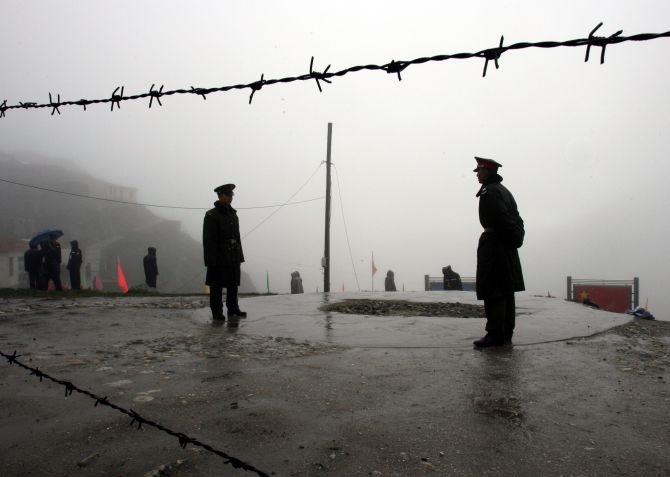 | « Back to article | Print this article |
Which way are the two Asian bigwigs headed?
What could be the reason for the Chinese to all of a sudden churn up the placid waters? Perhaps the reading on the banner is: no hobnobbing with ASEAN countries. But upping the ante along the borders has its own demerits for the Chinese. It serves to push India closer to the US thus strengthening the latter’s Asian pivot, says Brigadier (retd) S K Chatterji
There is a lot happening along the India-Tibet border. Nothing as big as the Syrian story, but definitely not the usual stuff, either. The decades old Line of Actual Control between the two Asian giants always had norms governing transgressions practiced by both parties.
However, the Chinese sending a patrol 19 kilometres deep, by India perceptions, in the Depsang area of Ladakh, and billeting themselves there for weeks, turned it all on its head. Amazingly, the entire sequence was played out just before the new Chinese prime minister visited India in May, 2013; the first port of call for him, post anointment.
Please click NEXT to read further...
Which way are the two Asian bigwigs headed?
A few other aggressive acts followed in the wake of Depsang incident and even after the premier’s visit. The Indian foreign minister also visited China, after trying to stem domestic apprehensions by statements trivialising the issue; notwithstanding the fact of statements by national leaderships being considered as strategic indicators of a nation’s perceptions and intent, in diplomatic parlance.
Which way are the two Asian bigwigs headed? The last that boiling points were reached at the borders was during 1967 in Sikkim and 1986-87 in Sumdorong Chu area. The 1967 incident lead to an artillery duel, while at Sumdorong Chu, the Indians had responded by putting an entire corps -- approximately 60,000 to 70,000 troops -- on alert.
This time the Indian government announced the raising of a mountain strike corps. However, the timeline is six to seven years.
What could be the reason for the Chinese to all of a sudden churn up the placid waters?
Please click NEXT to read further...
China's message to India: No hobnobbing with ASEAN countries
The fact that it almost coincided with the Chinese prime minister’s visit, is symbolical. Perhaps the reading on the banner is: no hobnobbing with ASEAN countries. If Indians partner ASEAN countries in the South China Sea exploitation, the Chinese can bring the problem closer home; right to Indian borders.
The Chinese would also be aware of the logistical disadvantage that the Indian forces have to contend with. Unlike the Chinese road network in Tibet, the Indian side is yet to put in place logistics arteries for an intense battle in mountainous terrain.
Of course, Indians have reactivated old landing grounds at Daulat Beg Oldie, Fakuche and Nyoma, all of them in the Indo-Tibet border regions, raising concern in Beijing; though far short of similar capability enhancement undertaken by the Chinese in Tibet.
There is obviously an effort to demean India’s status among ASEAN countries. A few of them had either progressed sea bed exploitation with Indian partnership, or stated openly in favour of greater Indian involvement in the region. Indian stocks bowing low also reduces its influence on its south Asian neighbours, whom China courts.
Please click NEXT to read further...
The Chinese concerns
It could also be to keep India more focused along its own borders thus alleviating threat perceptions that Pakistanis suffer, with their heavier deployments along the Afghan borders.
What has also unnerved China lately, is Myanmar moving out of orbit and the impact on the Chinese neighbourhood. Further, the professed shift of American prowess eastwards, combined with a withdrawal from Afghanistan that allows greater focus and resources to the east, add to it.
There is also the long, even and strengthening Indo-Japanese relationship and the latter quite forcefully defining its territorial claims; the detention of men on board two Chinese fishing trawlers in East China Sea being a case in point.
Perhaps, the Chinese also gamble on the Indian leadership underplaying such incidents to pass the message to its citizens of everything being under control. With the elections scheduled in 2014, such expediency is neither rare nor new in democracies.
The fact of the Indian economy losing momentum, the plethora of financial irregularities, slow pace of financial reform also emphasise the vulnerability presenting an opportunity to the Chinese to snub India.
The incidents are also possible indicators of greater militarisation of the Chinese top leadership; it’s propensity for using force that may also reflect in its domestic governance.
Please click NEXT to read further...
All is not advantageous for China
The Indian response, beyond getting its road and rail network in its border states in place and modernising its military inventory and diplomatic counter-manoeuvres, needs to include an equitable military measure.
Post the Pakistani incursions in 1999 in the Kargil area, and the attack on the Indian Parliament by Pakistan- based terror groups, the entire Indian Army was mobilised. It isn’t that such a step is called for, but the parallel is quoted to put the range of possible options in perspective.
Upping the ante along the borders has its own demerits for the Chinese. It serves to push India closer to the US thus strengthening the latter’s Asian pivot.
As on date, the Chinese can definitely expect a bloody battle, though being militarily superior.
Click on NEXT for more...




